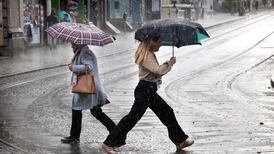US tourists in Ireland spend more than any other visitors. After a big drop in recent years, are they returning, asks Rosita Boland
For many, many years, we took them entirely for granted: the American tourists in Ireland. There were so many tour buses that they had to travel one way (anti-clockwise) along the narrow roads of the Iveragh peninsula's Ring of Kerry. The too-white and brand-new-looking báinín jumpers and caps marked out at least some of them, as did the rather daft and innocent questions about whether we had running water, where had all the donkeys gone and why were there so few thatched cottages? We giggled at the trade in shillelaghs, the made-in-Hong Kong leprechauns and the "hot Guinnesses" - aka Irish coffees - requested in pubs.
Like the cuckoo, March 17th traditionally heralded the beginning of the tourist season, with the presence of esoteric American marching bands pounding down O'Connell Street in Dublin, accompanied by incredibly upbeat cheerleaders. The cheerleaders wore short skirts! In March! Again we giggled. Those funny Americans!
Well, come September 11th, 2001, and the subsequent global downturn of the tourist industry, we weren't laughing any more. Thousands of Americans chose to stay at home.
In 2000, the North American segment of the tourist industry was worth €761 million to the island of Ireland. In 2002, it was worth €744 million. That might not sound too drastic a drop, but factor in two intervening years of inflation, and the figure then looks rather different.
"Also, what's important is where the impact of the drop was felt," explains Paul O'Toole, chief executive of Tourism Ireland, the body with responsibility for marketing the island of Ireland abroad. "The drop in the American market was felt most acutely on the western seaboard."
It still is. "The rate of recovery is not as pronounced there," admits O'Toole.
The North American part of Ireland's tourism is not the biggest segment in terms of numbers, but, crucially, it is the most valuable. Each American tourist spends, on average, €860 here.
Hardest hit by the Americans staying at home is what's known as "the escorted coach tour". One of the biggest operators in this area is Brendan Tours, which offers 12 different tours, ranging from six to 14 days in duration. Catherine Reilly, operations manager in Ireland and Britain, confirms that there has been a drop of 35 per cent in bookings since 2000. "We wouldn't be returning yet to 2000 figures," she says.
In 2000, Aer Lingus carried 690,000 passengers on its transatlantic routes into Ireland. In 2002, the figure had dropped to 595,000. Last year, it was 640,000.
The year 2000 is acknowledged in the trade to have been the best year for Irish tourism. Since then, it's not just the post-2000 impact of foot-and-mouth, September 11th and the war in Iraq which has reduced the number of American tourists to Ireland; the current weakness of the dollar is also a factor. And now the Madrid bombings will not have helped US confidence in European destinations. This has all resulted in a change in booking patterns in the American market, and the feeling in the trade is that the change is permanent.
Malcolm Connolly, director of industry developments at Bord Fáilte, confirms that the lead-in time for bookings is now much shorter than it was pre-2000. "At this time of year, in mid-March, traditionally we would have been able to forecast very accurately what the figures would be for the rest of the year," he says. "The later booking trend now means it's much more difficult to forecast what things will be like."
Internet bookings, and what Connolly describes as "an undercurrent of uncertainty about the possibility of terrorist incidents" mean that late and last-minute bookings are now the norm.
John Power is the chief executive of the Irish Hotels Federation.
"Late bookings initially started by arising from security concerns," he says. "Now it's a habit and I don't see it going back. More people are now making direct bookings on the net, and not through travel agents."
There are 1,600 B&Bs on the island of Ireland under the umbrella organisation of the Town and Country Homes Association. Chief executive Margaret Storey is reasonably optimistic about this year's American bookings, which are the biggest part of their market. While bookings here are also increasingly through the Internet, surprisingly "we still get people looking for our brochures to be posted over to them". At present, bookings for 2004 are on a par with last year.
For a while, even those St Patrick's Day American marching bands and cheerleaders stayed at home.
In 2002, only 427 performers arrived for the Dublin parade, as part of the week-long St Patrick's Festival, including a contingent from the Los Gatos High School Wildcat Marching Band in California. In 2003, the participants numbered 719. This year, the figures have crept up again, with 966 American performers expected, including 280 from the Copell High School Band in Texas.
So what continues to attract Americans to Ireland? Paul O'Toole of Tourism Ireland considers.
"The strong ethnic links - 40 million Americans claim Irish ancestry," he says. "Golf. Historic houses and castles. The fact that they see Ireland as a safe destination, and that they speak the same language. And they still love the idea of our welcome."










